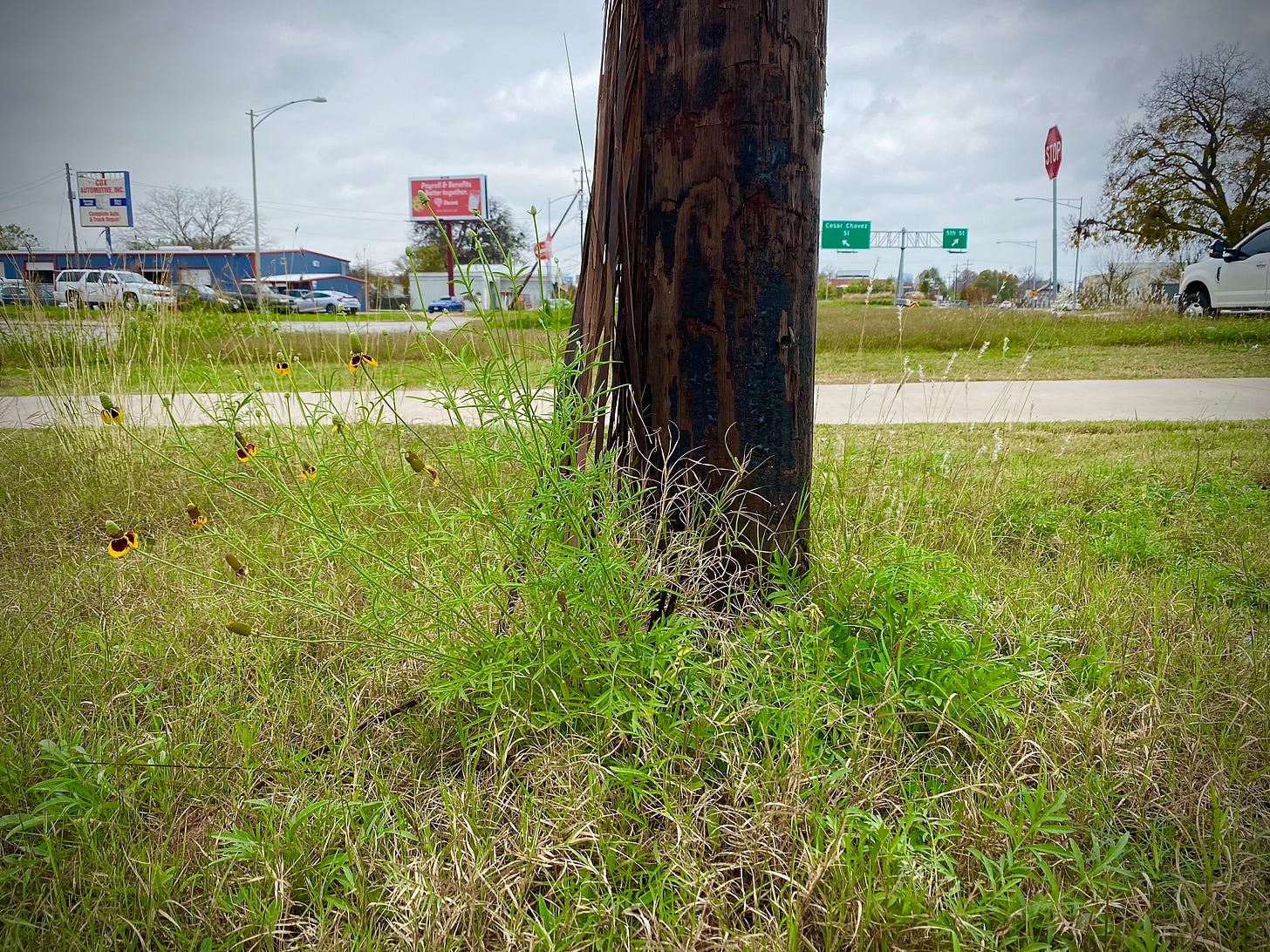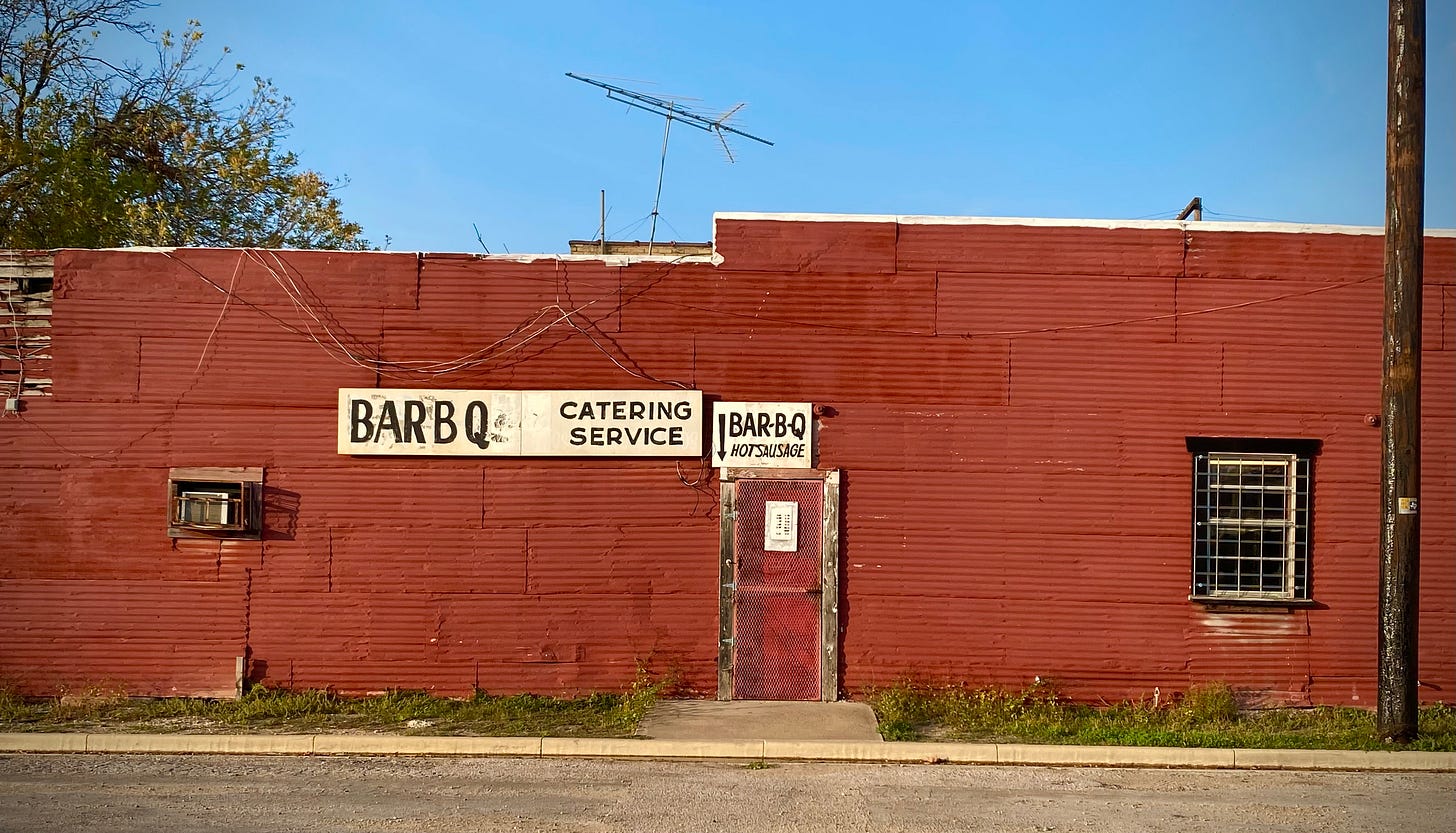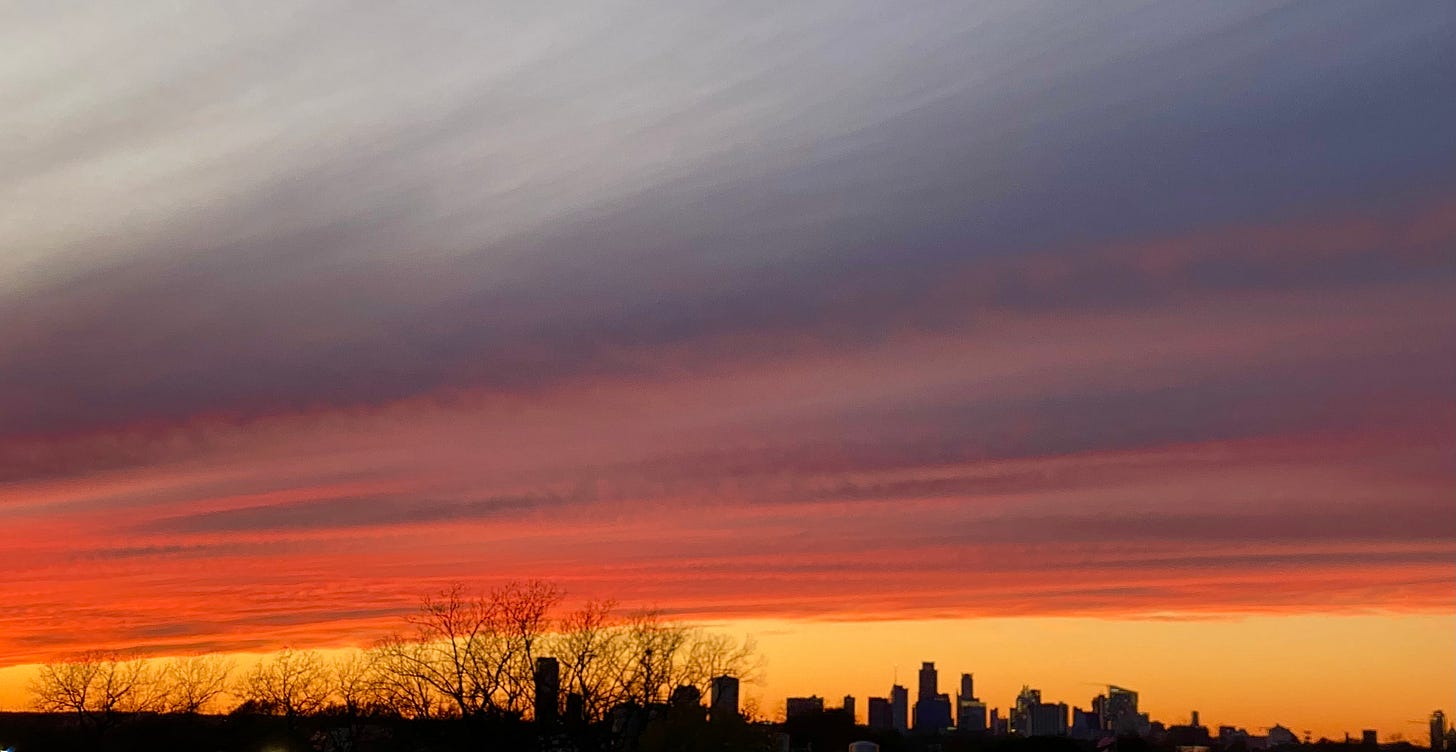Winter blooms
You can tell it’s winter in this part of Texas when the milkweed pods finally pop, just as the last butterflies are fluttering through. I hadn’t even noticed this milkweed vine growing up around the spiky branches of a volunteer retama in our front yard until its floating white hairballs started spreading across the yard. I don’t know why it is that wild vines do so well in this little zone behind the factories at the edge of town, but in the woods between us and the river, they grow thick as rope, so old and strong that they are coated with bark, draping the dark of the urban forest with shadowed lattices that bring out the Gothic and eventually bring down the trees that aren’t strong enough to resist.
In their shadows on the forest floor, the wildflowers of spring began to emerge from the ground after Thanksgiving and the rains that followed, right on schedule. The bluebonnets came up even earlier on the sandy bank of the old gravel dredge, their hairy little leaves crawling across the rocks, reminding you that the most popular state flower is one whose appearance usually reflects our abuse of the land. At the back of our lot, thick green clumps of spiderwort grow out of dirt packed with illegally dumped debris from demolished buildings and old roads.
In the field behind the gypsum board warehouse, the Johnson grass has finally died off for the season, making room for the native seed bank it has mostly crowded out. The prairie coneflower is the most prodigious of those natives, there and in the unmowed rights of way, where it emerges through the Bermuda grass. Out for a mid-day run on Thursday, I found some that had already bloomed at the base of the onramp. Maybe not a good sign, but who knows.
The Anglo settlers gave that wildflower the name Mexican hat, and people still call it that, even though the sombreros have been almost entirely replaced by cowboy hats in these parts. The name encodes a complex history of diversity, co-existence and colonization here at the edge of the borderlands, where the Blackland prairie once ran like a sea of grass from the north end of San Antonio to just south of the Red River.
I found a big remnant of that prairie Thursday afternoon, when I took advantage of a pause in the week to check out a site I had often read about but never seen. The prairie remnant probably wasn’t really a remnant, but it was a prairie, an acre of insanely thick and tall Indian grass there at the intersection of two jammed-up highways in what the Internet advises is the seventh fastest growing suburb in America. I wonder how long it will last.
On the long nineteen miles between Manor and Taylor, there were no more remnants, just farms, even as you could see from the shape of the land that it had once been covered in tall grass. I found the next one when I got to my destination, a corporate detention facility operated under contract for the U.S. Immigration and Customs Enforcement division of the Department of Homeland Security. The DMZ along its western edge has been allowed to go wild, and as I rolled up I saw a bright yellow yard sign with a cryptic warning: DO NOT FEED.
I saw no animal to feed. But it made me wary of getting out to walk.
If you saw it on some satellite map on your phone while looking for one of the nearby businesses, you could be forgiven for assuming the T. Don Hutto Residential Center is some kind of housing facility. In a way, it is. It’s a place where women who have been apprehended crossing the border without documentation are locked up pending their deportation or bonded release. It’s not hard to find—you can instruct your phone to take you right to the main gate—but when you see it for real you realize how it’s hidden in plain sight. A little outpost of dystopia on the wrong side of the tracks at the edge of America’s hometown.
Taylor is one of those suburbs evolving from a small town, far enough into the rural quarters of the next county that a trip there feels a little bit like time travel. My friends who do location work here for movies and television call it their back lot, a museum-quality specimen of old-fashioned Main Street with its vintage storefronts intact, stately middle-class homes occupied by smiling families, and settler-era farmhouses often occupied by descendants of the people who built them. There’s a sign at the main intersection that advertises the town motto: “Friendly as a Texan’s Smile.”
At the next corner I saw one of those smiling Texans drive off in his Route 66-ready 1950s Corvette. I went looking for the mythical location of SST Records, the L.A. hardcore label of my 80s youth that moved here with its proprietor, Black Flag guitarist Greg Ginn, late during the second Bush Administration, and found the address was a beautiful old post office from an era when that public service of the federal government was where you went to exchange handwritten messages with faraway friends. You can see why they used Taylor as the idealized Texas small town of Friday Night Lights. But the long list of feature films shot there reveals something creepier going on. The Hitcher, The War at Home, Transformers: Age of Extinction, and 1997’s Purgatory County:
In a small Texas town, an emotionally unstable native son, Perkins, returns after a long absence to find that his brother Duane has been elected sheriff. Much to Perkins’ shock, he also discovers that the ambitious and greedy Duane is having an affair with Perkins’ wife Liz. Perkins also learns that the family ranch has been turned into a failing emu farm, and that his abusive, chain-smoking mother has passed away and left him only the family gun collection.
The house where Leatherface lived in the The Texas Chain Saw Massacre is a few miles away, and now you can go there for brunch. The Chamber of Commerce probably did not take the executives from Samsung there before they chose Taylor as the site of their new $17 billion factory to fabricate chips for 5G devices and artificial intelligences.
Taylor is a town whose origin was as a railroad stop, and you can see how that land use structures the social landscape of the town, proving the truth of the all-American aphorism. The old downtown terminates at the big Union Pacific railyard, where huge trains run through all day long. When I arrived, I saw a hundred identical cars roll slowly by carrying loads of gravel east. Around the railyard are old warehouses, most of them dedicated to the movement of grain and cattle, and one dedicated to eating the product.
The businesses on the north side of the tracks are not as quaint as the ones on Main Street. Run-down hair salons, convenience stores, tattoo parlors, a cold storage meat locker with the sculpture of a big fat steer over the front door, a truck mod shop with a Punisher decal on the mailbox.
Another road runs parallel to the tracks on the south side. A rougher road, paved but unstriped, in the shadow of the highway overpass that lets people driving through avoid seeing that side of town as they go right over the tracks. There are more warehouses there, most of them newer Morton buildings, all of them behind high fences. There are old farms that come right up to the last blocks, one rising up as a hill where the edge of town resolves into some Texas mirror of a Wyeth landscape. There are a bunch of empty lots, some of them marked on the map as municipal parks, but all of them fenced in and marked with warnings to trespassers, except for the little prairie where the mystery creature lives. In the field behind the detention facility, the remains of this season’s cotton crop lay on the ground like summer snow.
There are a few residential blocks back in there, more ramshackle than the stately homes on the other side. One long block of little houses rich with Christmas decorations and yard toys looks out on the big empty lot where they have built a little ball field, behind which looms the corporate prison.
The morning before I drove out there I saw an ad in the paper inviting me to tune into a program in which Jenna Bush Hager, the more famous of the presidential twins, was hosting the Best of Humankind Awards. It was during her dad’s second term that the T. Don Hutto facility, named after one of the founders of the company that owns and operates it, was saved from closure by the opportunity to convert it from a medium-security private prison to a facility for the detention of undocumented immigrants who previously would have been released pending their administrative hearings. I remembered when her dad was governor, and we rode our bikes past his official mansion one Sunday morning and saw them all there on their back porch, a happy American family. W. even waved at us, with that same goofy smile his daughter inherited.
For all I know, there may be some people working in the T. Don Hutto Residential Center that would qualify the kind of awards for niceness that merit recognition by USA Today’s marketing team. But when you drive by the place, you can’t help but be awed by its expression of penal state power, even as you see the smiling workers headed to their cars or on break at the canopied picnic table right outside the main gate. Maybe it was the way the high fences and razor wire glistened in the late afternoon sun, or those windowless white boxes in the back with moveable staircases at the door and the intimidating blue logo of ICE printed in huge letters on the side. The way the facility expresses the union of federal authority and corporate capital in service of maximum control over the land we conquered.
Until a few years ago the facility was used to detain mothers and children. You imagine it from the point of view of some kid who traveled here from Guatemala or Honduras, a long and terrifying journey in search of sanctuary, only to be taken by armed officers and transported to this isolated compound, maybe in one of those windowless containers. I wonder if the detainees can see the fields, or hear the trains at night.
Friday afternoon I read a student’s paper explaining how the rail line that passes in front of the detention center follows the path of an ancient trail that came up from Mexico and followed the line of springs that still flow in the long thin band where the Blackland prairie marked the liminal space between the eastern plains and the arid west. A reminder of how against nature political borders are, concretizing the permanent settlement, indenture and territorial exclusion of a species that was born to roam.
When I made my second pass by the facility after touring the town, I saw a woman out in the prairie next to the prison. She was there with some big weird white dog, with food in her hand. When I looked up the photo later, I realized she was a volunteer for the local no-kill animal shelter, feeding a stray in the shadows of a camp where they lock up women.
Next to that empty lot is another one with three scrubby mismatched trees and a cell phone tower. I remember the saying my friend in Tijuana coined, ten years ago this spring: BORDER CLOSED. NETWORK OPEN.
Further reading
I took this week’s field trip to prepare for Saturday morning’s kick-off event for the Carceral Edgelands project of the Bureau of Experimental Ethnography. The Bureau is University of Texas anthropologists Craig Campbell and Marina Peterson and English professor Casey Boyle, dedicated to using artistic practice to push the bounds of what traditional scholarship can achieve in advancing our understanding of the world around us. Carceral Edgelands focuses on the zones surrounding detention centers mapped out by the In Plain Sight project with an invitation to:
visit (virtually or bodily) the edgelands surrounding sites of immigrant detention with the aim of documenting experience through one or more of the following: writing and photography; compositions on a felt sense of anticipation, ambivalence, anxiety, or foreboding; in poems, found words, collections of sticks and plastic flotsam, memories of smells and conversations, or whatever else seems important to you.
For more on the history of the corporate detention facility I visited, its founder namesake, and the dystopian business of private prisons, check out this excellent Mother Jones piece by journalist Shane Bauer, who spent six months undercover as a guard in another CoreCivic (fka Corrections Corporation of America) facility, and won several major prizes for his reporting on the experience.
Via Bruce Sterling, an excellent piece at .coda about how the surveillance apparatus deployed in Arizona has proved far more effective—and lethal—than the physical border wall of the prior administration.
Also via Bruce, a fascinating report from UT about recent research that suggests the Texas pterosaur Quetzalcoatlus lived and flew a lot like a contemporary heron.
Farther north, the NYT had a great feature about the plans to “daylight” Tibbetts Brook, a creek in the Bronx that has been buried under concrete since 1912. It seems like there are a lot of similar projects on the boards, and it will be exciting to see what different cities do with these opportunities.
The Sunday after Thanksgiving, the NYT style magazine “T” had a piece about the novel wreaths being made by English florists. It planted the idea in our head, and Saturday after nap, baby, mama and I went out and made wreaths from the wild plants in our yard. Mine had mustang vine as the base, layered over with Indian grass and cardinal flower. It was fun, and it looked kind of cool if also pretty crazy.
Have a great week.














Excellent as always.
Great read! I loved your wreath. I think I’ll try it at Timberhill.